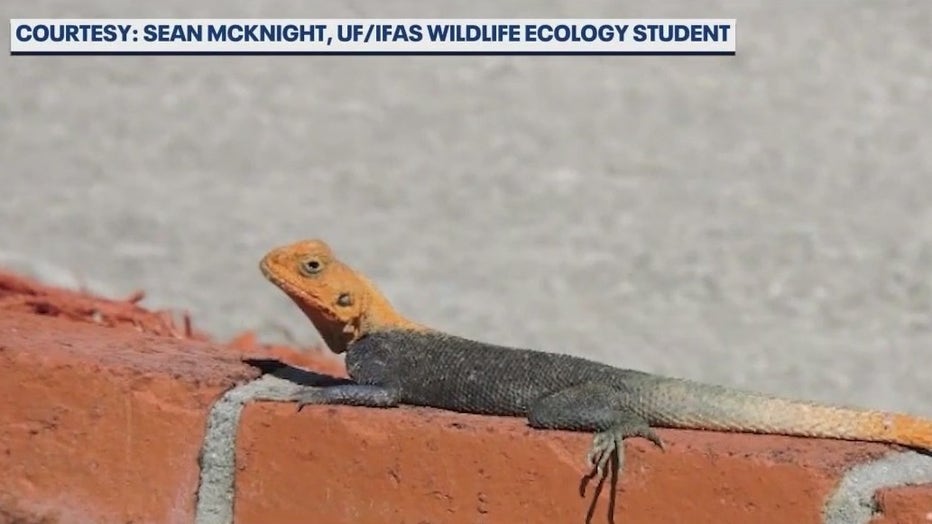Invasive lizard from Africa settling into parts of Central Florida
Invasive lizard settling into Central Florida
An invasive lizard is making its way up the East Coast from south Florida.The Peter's Rock Agama has a brightly colored head that immediately grabs your attention. It's larger than most lizards, and many people are curious about the new species they see more often.
WEST MELBOURNE, Fla. - An invasive lizard is making its way up the East Coast from South Florida.
The Peter's Rock Agama has a brightly colored head that immediately grabs your attention. It's larger than most lizards, and many people are curious about the new species they see more often.
Jingchen Bi was caught off guard when she saw the unique species clinging to a wall in West Melbourne.
"Oh my God. Something is on the wall!," she exclaimed.
This red-headed lizard stopped the family in their tracks to capture the creature on video.
"I saw the head. It is red, and it’s pretty abnormal, and I have never seen a lizard that big," said Bi.
That big lizard she saw is a Peters’s Rock Agama, an invasive species originally from Africa that’s thriving in the Sunshine State and moving north in droves.
"I don’t know if they will attack or bite or if they’re poisonous. I don’t know," said Bi.
FOX 35 took her questions to someone who knows. Ken Gioeli is on the cutting edge, researching this species and its success in Florida.

Peters’s Rock Agama
"I refer to this as the invasion front, just like you have an army at war," said Gioeli who’s a natural resources extension agent with the University of Florida.
Gioeli has been studying the agama for years. He says they were released in 1979 and were primarily spotted in south Florida. Now, they’re on the move.
MORE HEADLINES:
- Florida neighbors, wildlife rescuers save baby eagle that fell out of its nest: 'It was awesome!'
- Watch: Rare deep-sea squid lunges at camera
- Endangered Species Day 2024: 10 of the world’s most endangered animals revealed
- Cicadas are on the menu for this stay-at-home dad's YouTube channel
"Sooner or later, the climate will stop them, but I would not be surprised if we don’t hear from St. Augustine that they’re on their way there," he said.
FOX 35’s Esther Bower asked the expert if the invasion hurt other species since they weren’t supposed to be there.
"The answer to your question is – we know they’re there," said the researcher. "They’re causing some impact to the environment, but we still don’t yet have a total handle on what it is that they’re doing."
Researchers across the state need help tracking the invasive lizard. He says if you see one, you need to report it. He recommends downloading an app called "ivegot1." He’s asking the public to upload a picture or video so scientists can escape the invasion.
Alligator drops by unannounced at Florida home
What do you do when there's a loud noise at your door that causes your dogs to start acting crazy? That's just what happened to a woman who lives in Indian River Colony Club in Viera. She went to her front door to check it out, and that's when she discovered a massive alligator that decided to drop by uninvited.
"Get a handle of where they are now and then try to jump ahead and predict where they could be going," said Gioeli.
Experts say lizards aren’t necessarily dangerous, but people shouldn’t approach them in the wild. They eat other lizards and have been known to take down birds in Africa.
"I mean, it’s scary. It’s just like a monster crawling so fast," concluded Bi.
She doesn’t want to see an agama again, but we all probably will because this invasion is just starting in Central Florida.

